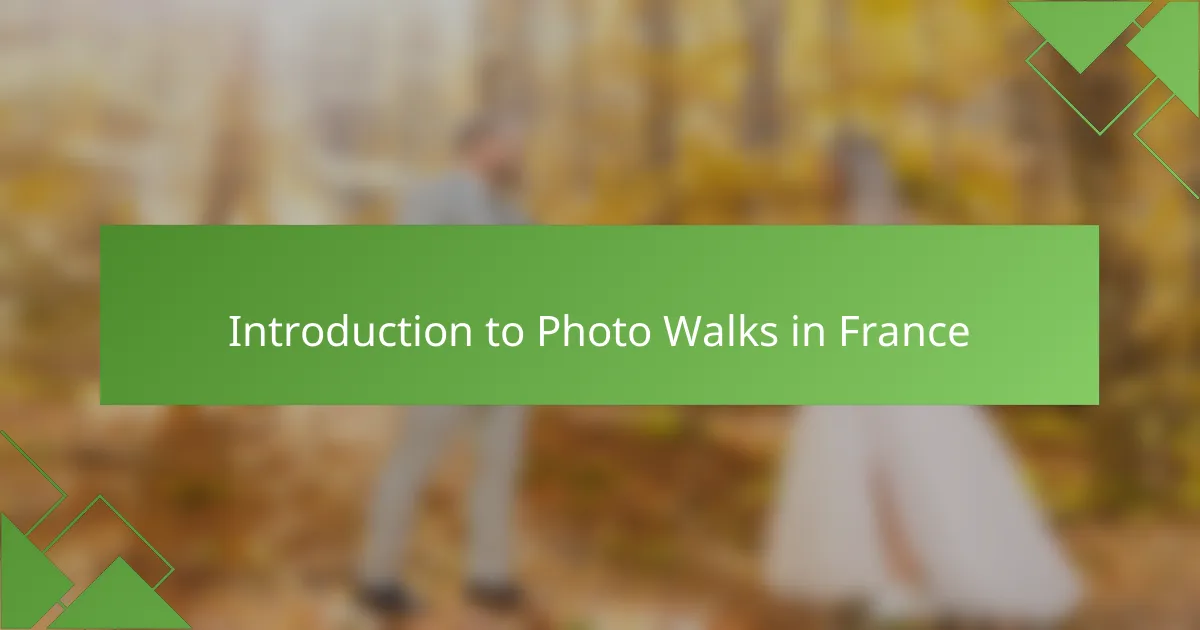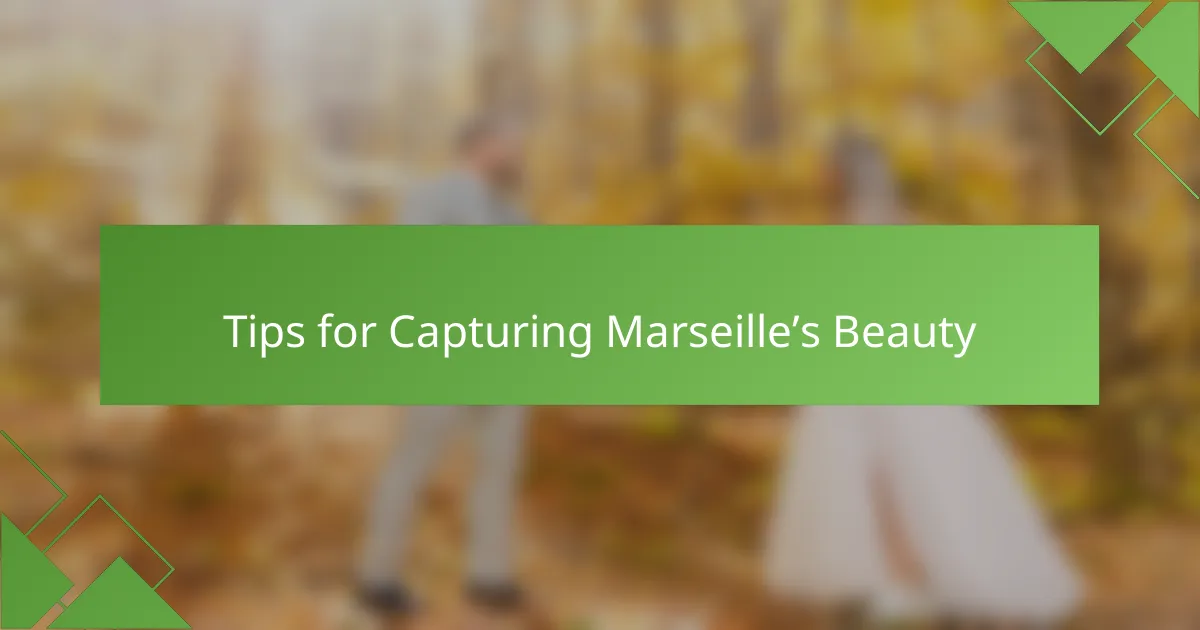Key takeaways
- Photo walks enhance creativity, improve photography skills, and foster connections among enthusiasts.
- Planning a route with key locations allows for capturing a cohesive story while remaining open to spontaneous discoveries.
- Utilizing appropriate gear, like a lightweight camera and versatile lens, significantly contributes to capturing dynamic moments.
- Engaging with local culture and shooting during golden hour can elevate the authenticity and beauty of photographs.

Introduction to Photo Walks in France
Photo walks in France offer a unique blend of exploration and creativity, allowing photographers to immerse themselves in the vibrant culture and stunning landscapes. I often find that capturing local life through my lens transforms a simple stroll into a profound journey of discovery. Have you ever walked through a bustling market or along a peaceful riverbank with your camera, feeling the pulse of the city in every shot?
In my experience, each photo walk is an opportunity to narrate a story, whether it’s through the striking architecture of ancient buildings or the candid laughter of locals. It’s fascinating how a single moment can evoke such strong emotions, isn’t it? I remember my first photo walk in France, where every corner I turned led to an unexpected scene, and my camera was my passport to capturing memories.
Participating in a photo walk not only enhances your photographic skills but also fosters connections with fellow enthusiasts who share the same passion. The discussions about techniques, locations, and personal experiences create an enriching environment that I find incredibly motivating. When was the last time you felt inspired by your surroundings? In France, that motivation is around every corner, waiting to be captured.

Importance of Organizing Photo Walks
Organizing photo walks is crucial because they create a structured environment for photographers to explore creativity and improve their skills. During my photo walk in Marseille, I found that having a clear plan allowed me to focus less on logistics and more on capturing the stunning architecture and vibrant street life. When you know where you’re going and what you want to achieve, the experience becomes that much richer.
From personal experience, the camaraderie among participants can enhance your photography journey. Sharing tips, insights, and the excitement of discovery adds a layer of enjoyment to the process, making every click of the shutter worthwhile. Here are some key advantages of organizing photo walks:
- Community Building: Connect with like-minded individuals who share a passion for photography.
- Skill Development: Learn from peers and gain constructive feedback on your work.
- Creative Inspiration: Explore new settings and subjects that might not come to mind during solo shoots.
- Practice with Purpose: Focus on specific themes or techniques, leading to more intentional photography.
- Networking Opportunities: Meet local photographers and build lasting relationships in the field.

Essential Gear for Photo Walks
When gearing up for a photo walk, the first essential item in my bag is always my camera. I prefer a lightweight mirrorless option because it allows for mobility without sacrificing image quality. Have you ever felt the difference when capturing street art or candid moments without the bulk of a heavy DSLR? It’s liberating, and the shots often feel more natural.
Then there’s the importance of lenses. I often bring a versatile zoom lens that can cover wide-angle and moderate telephoto shots. I remember strolling through Marseille’s vibrant markets—there’s something magical about being able to zoom in on a vendor’s detailed expressions while also capturing the wider scene. This flexibility not only improves my storytelling but also keeps my creativity flowing in dynamic environments.
Finally, don’t underestimate the value of a good sturdy tripod. Whether it’s for low-light shots during sunset or ensuring stability for high-resolution images, having a tripod can make a significant difference. I’ve found that taking the time to set my camera on a tripod opens up a world of creative possibilities, especially in bustling locations where I want to capture the stillness amid the chaos. What can I say? Every detail counts in the art of photography!

Planning Your Photo Walk Route
When planning my photo walk route in Marseille, I always start by identifying key locations I want to capture. For instance, I find the Vieux Port particularly captivating, with its stunning blend of boats and historical buildings. How often do you encounter a scene that seems to encapsulate the spirit of a place? Knowing my must-visit spots helps me create a flow to my walk, capturing the essence of the city with every click of the shutter.
I typically use mapping apps to visualize my route, considering both good lighting and the angle of sights I wish to shoot. I remember one day, standing on a sidewalk as the sun set behind the Notre-Dame de la Garde; the way the light danced on the buildings was spellbinding. Such moments reinforce the importance of timing and location, enhancing the narrative each photograph tells.
Additionally, I think about the stories I want to tell. Including a mixture of bustling market scenes and serene waterfront shots adds depth to my portfolio. It’s not just about the landmarks; the local cafés or street musicians can provide context and vibrancy. Have you ever considered how a simple café scene can tell you more about the local culture than a grand monument? Planning my route allows for spontaneous discoveries while still having a cohesive story.

Tips for Capturing Marseille’s Beauty
When I wandered through the vibrant streets of Marseille, I realized that the city’s charm lies not just in its stunning architecture but also in the everyday life of its residents. Capturing candid moments, like a local enjoying a café or children playing near the Old Port, added a layer of authenticity to my photos that I truly cherish.
Experimenting with light is essential. The warm glow during the golden hour transforms ordinary scenes into magical compositions. I recall one evening, as the sun dipped below the horizon, the colors painted the sky and the buildings with a golden hue, making everything look dreamy. It was moments like those that spurred my creativity and pushed me to snap picture after picture.
Tips for Capturing Marseille’s Beauty:
– Shoot during golden hour: This is the time just after sunrise or before sunset, when the light is softer and warmer.
– Focus on details: Look for intricate architectural features or textures in the buildings.
– Incorporate local life: Try to capture the daily activities of the residents for a more authentic feel.
– Seek out different angles: Change your perspective by shooting from low or high viewpoints.
– Explore hidden corners: Some of the best shots come from wandering off the beaten path and discovering less-known spots.

Personal Experience of Organizing in Marseille
Organizing a photo walk in Marseille was an exhilarating experience for me. I remember the thrill of planning the route, carefully selecting vibrant locations that highlighted the city’s unique charm, like the bustling Old Port and the stunning architecture of the Basilica of Notre-Dame de la Garde. Each spot I chose held a special story, and I felt a personal connection to them, making the event feel more significant.
As the day approached, I was a mix of excitement and nervousness. Would the participants enjoy the journey as much as I did? When we finally set out, the energy was infectious. I cherished those moments of sharing tips, laughter, and capturing the beauty of Marseille together. It reinforced my belief in the power of photography to connect people and create lasting memories.
| Aspect | Personal Experience |
|---|---|
| Planning the Route | Chose iconic spots for their beauty and stories |
| Emotions | Excitement and nervousness mixed |
| Group Interaction | Shared laughter and learned from each other |

Final Thoughts on Photo Walk Success
Reflecting on my photo walk in Marseille, I can confidently say that success lies in the blend of preparation and spontaneity. While I had a loose plan of must-see spots, the magic often happened when I stumbled upon vibrant street art or when the light hit just right. One moment that stands out was when an elderly couple stopped to admire my work; their smiles as they shared stories about the city warmed my heart and added a personal touch to the entire experience.
- Ensure you have a flexible itinerary; while it’s great to know where you’re headed, allow room for unexpected discoveries.
- Engage with locals; their insights can lead you to hidden gems and enrich your photographic narrative.
- Pay attention to lighting; I found that early mornings or late afternoons provided the best natural light, enhancing my captures.
- Bring extra gear, but travel light; you want to be prepared, yet agile enough to chase spontaneous opportunities.
- Always keep an open mind; sometimes, the best shots come from the least expected places.